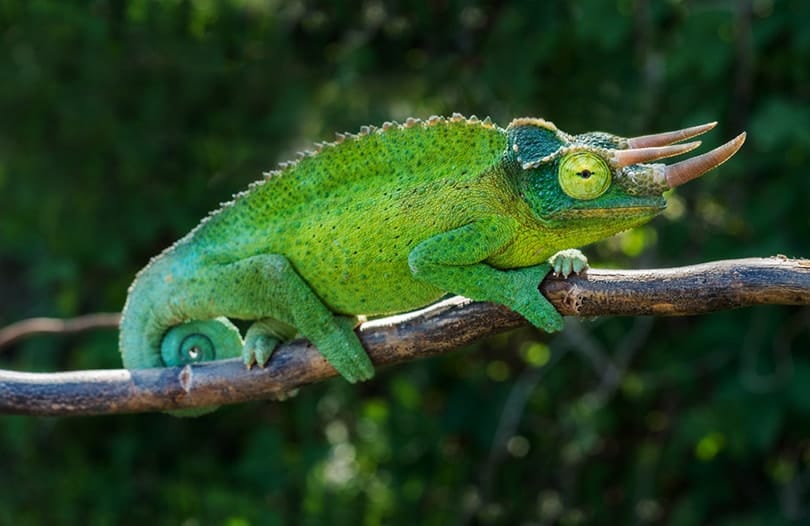Jackson’s Chameleons are fascinating creatures with a twig-like motion to their movement!
The Jackson’s Chameleon Chamaeleo jacksonii is best suited to being a visual pet and watching them is captivating. It is amazing to see them move with their rocking gait, as if to mimic the twigs of a tree or bush. Watching them eat and the speed at which their tongue darts from their mouths to catch prey, is astounding. And as with almost any chameleon, they can also change their colors.
The Jackson’s Chameleon, also known as Jackson’s Three-horned Chameleon, comes from Africa in the mountains of Kenya. There are three subspecies. The Jackson’s Chameleon Chamaeleo jacksonii jacksonii is the nominate species. The other two are the Dwarf Jackson’s Chameleon C. j. merumontanus and the Yellow-crested Jackson’s Chameleon C. j. xantholophus.
The name Three-horned Chameleon is derived from the male having three brown horns. One of the horns extends from the nose and the other two extend from the superior orbital ridges above the eyes. The structure of its taxonomy, as with many lizards, is in a state of flux. Another scientific name for these chameleon species is Trioceros jacksonii. The word “trioceros” is a Greek derivative from the combined terms”tri” which means “three”, and “keras” which means “horns”.
The Jackson’s Chameleons are reptile pets for the more advanced hobbyist. Jackson Chameleons are not the easiest nor the cheapest lizards to keep. They can be easily stressed and they don’t particularly like to be handled. They need a more specialized environment with a good amount of space, and a degree of solitude. But in a proper habitat with good care, they can provide hours of fascination and joy for a dedicated keeper.
- For more information on keeping Lizards see: Reptile Care: Keeping Reptiles and Amphibians as Pets
Scientific Classification
| Kingdom: | Animalia |
| Phylum: | Chordata |
| Class: | Reptilia |
| Order: | Squamata |
| Family: | Chamaeleonidae |
| Genus: | Chamaeleo |
| Species: | jacksonii |
Scientific Name
Chamaeleo jacksonii(Trioceros jacksonii)
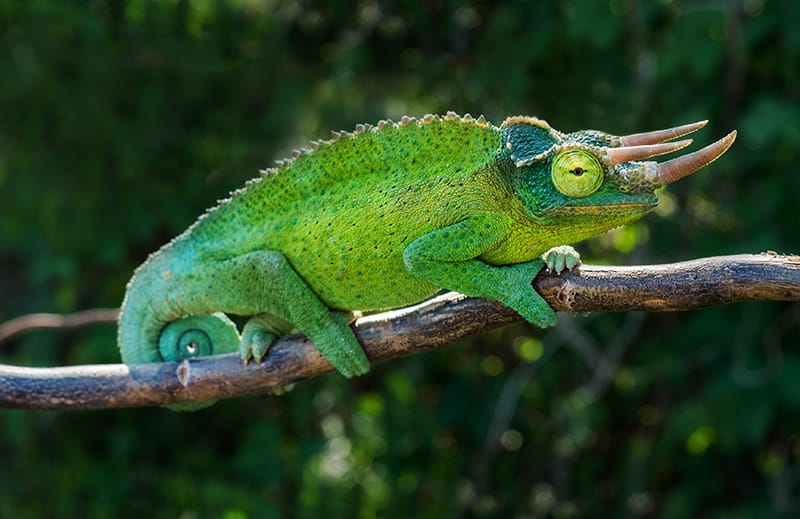
Habitat: Distribution/Background
The Jackson’s Chameleon Chamaeleo jacksonii was described by Boulenger in 1896. It is found in the mountains of Kenya, Africa. These lizards had a very long and confusing period of discovery in the taxonomical world, but were originally documented by G. A. Boulenger. The first specimen was donated for study by F. J. Jackson. There are a few variations of the Jackson’s Chameleon, which is part of what caused the long taxonomic debate.
There are currently three recognized subspecies of Jackson’s chameleon:
- Jackson’s Chameleon, Jackson’s Three-horned Chameleon C. j. jacksonii
This lizard species is an intermediate size and has a dark to dusty pigmentation of the crest at the top of the head. - Dwarf Jackson’s Chameleon C. j. merumontanus
This chameleon species is smaller than the nominate race and has a lighter-colored crest. - Yellow-crested Jackson’s Chameleon C. j. xantholophus
This is the largest of the three subspecies and has a yellow crest.
Status
The Chamaeleo jacksonii is not on the IUCN Red List for Endangered Species.
Description
C. j. jacksonii is the most popular of the three subspecies of Jackson’s Chameleon. This chameleon is around five inches long from snout to hind legs. This measurement is excluding the tail. The crest is yellowish in color or at least much lighter than the color of the body. The body color of this chameleon is generally a light green, though they can change color at will.
The horns of this species are not as prominent as those of the other two species, and in the case of the females, can cease to be visible at all. Juveniles will not display the elegant horns of the males, but may have rostral horns or ‘nubs’ at the tip of the nose. The females may never develop any further than those ‘nubs’ as they mature into adulthood.
Food and Feeding
The Jackson Chameleons are insectivorous, meaning that they eat insects and other invertebrates. Neonates, or newborns, can be fed wingless fruit flies and 1-week-old crickets. In the adult chameleon, fifty percent of the diet should be comprised of crickets. They will also eat meal worms, wax worms, and butter worms, spiders, roaches, and other invertebrate prey.
Gut loading your crickets with fresh fruit, vegetables, fish flakes, and any of the commercially available gut load diets will increase their nutritional value. Prey items need to be dusted with a mixture of 2/3 of a vitamin supplement such as Herptivite and 2/3 calcium powder that also offers Vitamin D3.
Water sprayed on the leaves of interior decor may be eagerly lapped up by many chameleons. One way to do this is to place a dripper on top of the cage and let the water slowly drip down into the cage and onto the leaves of the plants. We have used a styrofoam cup with a pin hole poked in the bottom of it to accomplish this. There are also water drippers available from pet stores.
These chameleons are rumored to not drink out of a water bowl. Even if this is true a water bowl is still a good idea to have in the cage, especially a bubbling water bowl as it helps to keep the cage humid. Use dechlorinated water, a good dechlorinator is Repti-safe which also provides calcium and electrolytes. The water dish should be refreshed daily. The cage should be misted at least twice a day, and the chameleon itself can be sprayed as well.
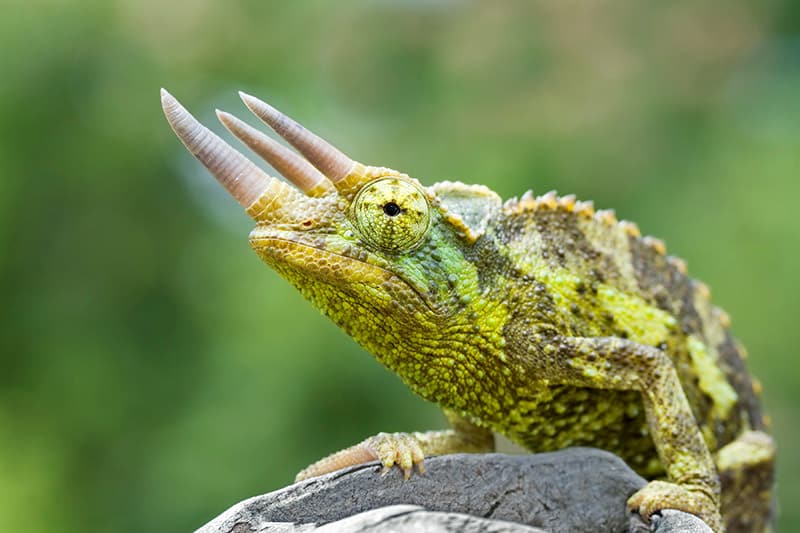
Housing
Jackson’s Chameleons require quite a bit of space for their size. The minimum caging requirement for these lizards is a 2′ x 2′ cage, with the height as high as is available. These are arboreal or tree-dwelling animals, and they need to have room to climb.
Cages can be made of screen, plexi-glass, or glass. Screen cages are commonly available in many pet stores. Besides size, two other enclosure requirements need to be considered for these chameleons: high humidity and good ventilation. Cages made totally out of glass or plexi-glass can cause mold and mildew problems, but there are a couple problems with all screen cages too. Maintaining high humidity, an important factor for these lizards, is essential. Secondly, bedding can spill out through the screen.
One good solution is to use plexi-glass panels, attaching them to an all screen cage as needed; i.e.. on the top and on two sides. This will help maintain a good ventilation flow, help keep the bedding inside and moist, and will also fostering a bit more humidity in the enclosure.
As the Jackson’s is an arboreal chameleon, he naturally needs branches to climb on. Many types of branches or attachable “jungle vines” are available in pet stores. Live or artificial plants may be used in the terrarium to allow the chameleon many varied surfaces to climb on.
Popular substrates for the Jackson’s Chameleon are peat moss, coconut fiber, and topsoil. Whatever the substrate, it should be kept moist, but not wet or soggy. If the bedding is too moist, and proper ventilation is not provided, the bedding will grow mold and mildew and these conditions are both extremely bad for your lizard’s health.
Temperature, humidity, and Lighting requirements:
A heat lamp may be provided for a little bit of heat, especially if the house is kept cool. The ideal overall temperature for the Jackson’s Chameleon is at 75{deg} F during the day with a temperature gradient of about 70{deg} -80{deg} F (21{deg} – 26.5{deg} C). A basking spot, provided by the heat lamp, but should not exceed 85{deg} F (29{deg} C). Nighttime temperatures are best at about 62{deg} F, dropping daytime temperatures by about 10{deg} – 15{deg} F (5{deg} -10{deg} C).
They do need both UV-A and UV-B exposure, which can be provided through fluorescent lighting. Keep in mind that UV rays do not travel through glass, so even keeping your chameleon in front of a window will not give them the necessary exposure. Even an open window will provide a challenge if the cage is made entirely of glass. If you are providing a basking area, be sure to mount incandescent basking lamps or heat emitters outside the cage to prevent burns.
The Jackson’s Chameleons need a humidity level of 50 – 80%. Mist the enclosure, especially the leaves of the plants inside, twice daily.The water bowl can also be used to help humidify the cage. Flukers (and other companies) produce a bubbling bowl that will put more moisture into the cage. If the humidity is still too low, a humidifier might be necessary.
Cage Care
Cage maintenance is an important part of keeping reptiles healthy, and long-lived. Reptiles being kept in a confined area as pets need to be protected from harmful micro-organisms and parasites. The reptile cage needs daily and weekly maintenance. Provide fresh food and water in clean dishes everyday. Check on a daily basis to make sure that the tank is clean. As the lizard defecates, the feces should be cleaned out entirely.
Everything you put into their home should be washed and disinfected weekly. This includes dishes and cage decor. The substrate should be changed out completely every three to four months, provided it hasn’t gotten moldy. If there is any odor of mold or mildew to the substrate, change it out immediately. Never clean with a phenol such as Pine Sol. Chlorine and alcohol based cleaners are tolerated much better, but need to be thoroughly rinsed.
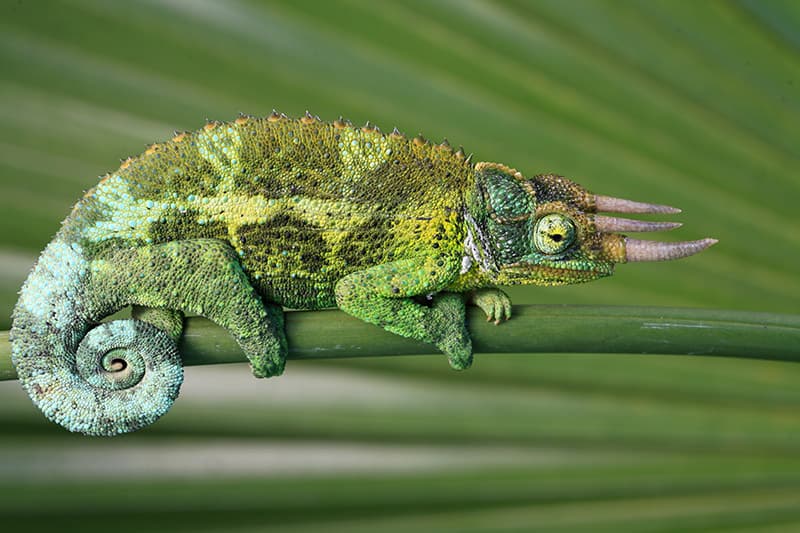
Behavior
The Jackson’s Chameleon should be kept singly, with males and females out of sight of each other. Even the sight of a male can be distressing to a female and can cause her to go off of her food. Introductions should only be made in the breeding season when the female is displaying signs of receptivity.
Chameleons in general are easily stressed by other pets and young children and it is highly recommended that they are kept in a quiet section of the house. Children should not be allowed to handle chameleons without careful parental supervision.
Handling
Chameleons are not as affectionate a pet as say, a bearded dragon. However, they will permit gentle handling. In some chameleon species, the color of your shirt can have an effect upon the chameleon’s mood. Whatever the case, avoid wearing black around your chameleon as this is a color of extreme stress.
Reproduction
Jackson’s Chameleons are sexually active at around five to six months of age. Care should be taken to let the females mature to a healthy weight before breeding, as premature breeding can cause unnecessary stress on the female and possibly lead to an early death.
These lizards are highly unusual in the fact that they have live births. Gestation is a quick 5 to 6 months long. They have two litters per year, with the heavier of the two being in June and the smaller of the two in December. The number of chameleons per litter ranges dramatically, from 8 to 35, depending on the size of the female.
Diseases: Ailments/Treatments
Chameleons can suffer from many problems, though the setup of their habitat is a common cause for most of them. Females in sight or being kept with males will often refuse to eat and will generally starve to death. Other problems with the Jackson’s Chameleon are grout, Vitamin D3 and calcium deficiencies, electrolyte deficiency, metabolic bone disease (MBD), acidosis, and alkalosis.
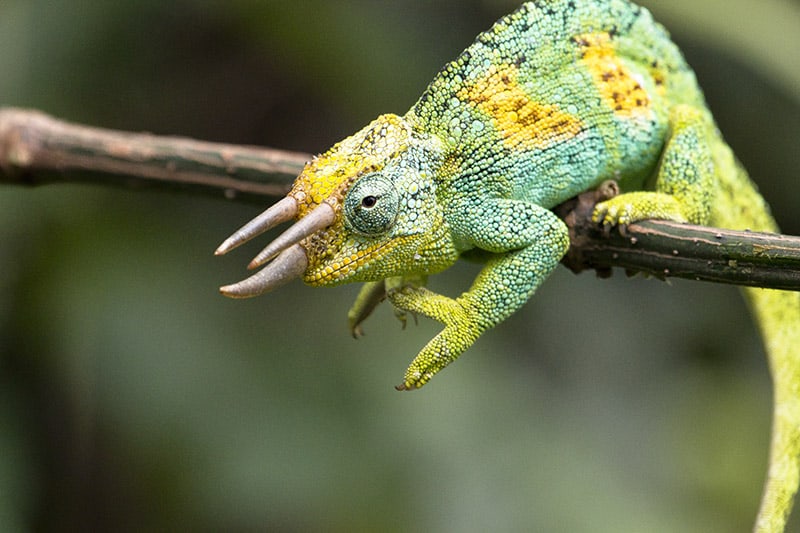
Availability
Jackson’s Chameleons are readily available through pet stores or private breeders in the $150 to $400 price range depending on age, locality, and sex.
Featured Image Credit: Jan Bures, Shutterstock
